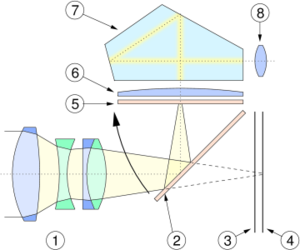Single-lens reflex camera
|
|
The single-lens reflex camera, more commonly known by the abbreviation SLR, uses a mirror placed between the lens and the film to project the image seen through the lens to a matte focusing screen. Most SLRs use a pentaprism to observe the image via an eyepiece, but there are also other finder arrangements, such as the waist-level finder or porro prisms.

The shutter in almost all contemporary SLRs sits just in front of the focal plane. If it does not, some other mechanism is required to ensure that no light reaches the film between exposures. For example, the Hasselblad 500C camera uses an auxiliary shutter blind in addition to its in-lens leaf shutter.
Since the technology became widespread in the 1970s, SLRs have become the main type of camera used by dedicated amateur photographers, and professionals.
The major advantage of single lens reflex cameras is the ability to determine what parts of the image are in focus by looking through the taking lens itself. Many modern SLRs offer additional focusing aids, including rangefinder devices and automatic focusing methods. To save weight and cost, many modern SLRs use mirrors instead of a pentaprism. However, the resulting image is usually somewhat darker than the one from a pentaprism.
The SLR cameras also offer the ability for the photographer to quickly and simply change the lens, thus making them versatile. The same camera can be used for portrait, landscape, action, and close-up photography. Whilst some earlier non-SLR cameras offered this ability, the SLR immediately allows the photographer to see what the different lenses will capture.
SLR cameras also avoid the difficulty of parallax in close-up photography. Cameras with a separate optical viewfinder system show the scene from a different viewpoint from that of the camera lens. For photography at normal distances, this difference is not significant, but where the gap between the viewfinder and lens is a significant fraction of the distance to the objects in the scene to be photographed, this difference in viewpoint may mean that the image recorded is quite different from that seen through the viewfinder.
K1000.jpg
The majority of SLR cameras use 35mm film, as this format offers a good compromise between image quality, size, and cost for most amateur and some professional applications. Professional photographers often use medium format SLRs for work where high image quality is important. Digital SLRs (DSLRs) have also appeared on the market and are now the camera of choice for most newspaper photographers, and are starting to be widely adopted by amateur enthusiasts. Single-lens reflex cameras using the Advanced Photo System film format were not popular.
Other features found on many SLR cameras include through-the-lens metering and sophisticated flash control. Many models on the market today actually measure the light that bounces off the film, and close the shutter when the picture has had enough exposure. Likewise, they can send out several short bursts of flash, determine the amount that comes back from the scene, then send out just the right amount of energy for a perfectly exposed photograph. Sophisticated cameras can even make it easy for the photographer to balance flash and available light for the desired look. While these capabilities are hardly unique to the SLR, manufacturers included them early on in the top models, whereas the best rangefinder cameras adopted such features later.
The pros of SLR camera are:
- Absence of parallax
- Exact focusing, esp. important for macro and telephoto photography
- Ability to check the depth of field (a feature often omitted on low-end SLRs)
- Vast range of interchangeable lenses (this feature is generally available also on high end rangefinder cameras (most notably the Leica, but the SLR concept is perfect for it)
- The most commonly used (and cheaply available) SLR lenses offer a wider aperture range, and more importantly, a larger maximum aperture (typically f 1.4 to 1.7 for a 50mm fixed lens) than compact camera lenses. There are two main advantages to this: a) Photos can be taken in lower light conditions without a flash b) A narrower depth of field can be achieved making the background appear more blurred, which is desirable in certain cases, particularly portrait photography.
The cons of SLR camera are:
- Due to mechanical complexity and the bulky finder, the SLR camera is larger than a rangefinder camera for a given film size.
- Latency; the mirror needs time to move before the film is exposed. On modern SLRs, latency is generally increased by autofocus, and can be a real inconvenience.
- Noise and vibrations, mainly due to the mirror movement. Some SLRs have a facility to lock the mirror in the up position prior to exposure in order to reduce vibration. However this is only practical for subjects that stay relatively still as with the mirror up, the viewfinder is not usable.
- Inability to see what is happening outside the viewfinder frame while shooting. This is a major feature of rangefinder cameras.
- Dark viewfinder when using low aperture lenses.
- Limited exposure times when used with electronic flash units.
- Difficulty in constructing wide-angle lenses because of the space-consuming mirror movement.
History
Graflex produced SLR cameras as early as 1909. The modern 35mm SLR concept was introduced by the Exakta in 1936. Significant SLRs that set a standard were the Hasselblad, the Contax S / Praktica, the Asahi Pentax, the Minolta SRT 101, the Nikon F and the Minolta Maxxum 7000. The Polaroid SX-70 was one of the few SLRs produced by that company, and perhaps the only folding SLR ever built.
New Digital SLRs like Canon Digital Rebel 300D and Nikon D70 have made SLRs easier to use.
See also
es:Cámara réflex fr:Appareil photo reflex he:מצלמת רפלקס nl:Spiegelreflexcamera ja:一眼レフカメラ pl:Lustrzanka jednoobiektywowa zh-cn:单反相机 ru:Зеркальный фотоаппарат
